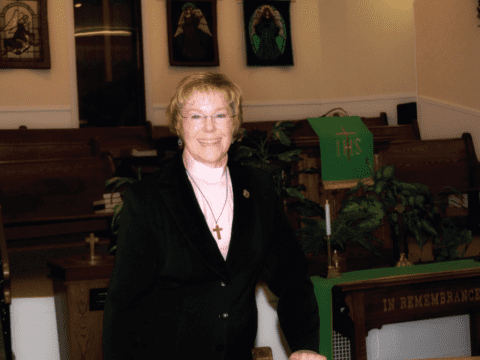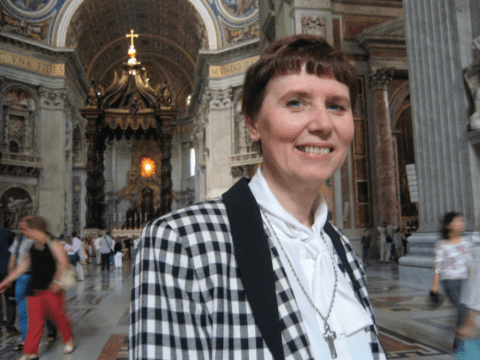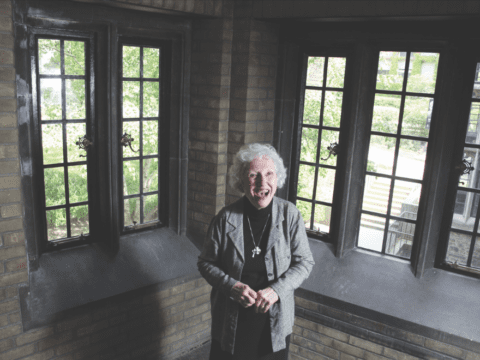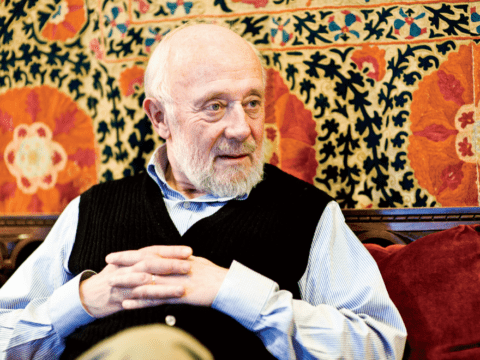In the remote Prairie farming village of Lyleton, Man., the general store has shut down. The post office is not expected to survive the retirement of its postmistress. The family doctor is a distant memory. Children spend several hours a day on a school bus. But the local United church is still open and active.
For seven generations, the people here have farmed and worshipped with a steadfastness rooted in the cycles of nature, family and community. Seedtime and harvest, christenings and weddings, reunions and funerals, Advent and Lent, Easter and Pentecost. The church, which is part of the Cornerstone Pastoral Charge at the confluence of the Manitoba, Saskatchewan and North Dakota borders, operates hand in glove with the community hall, the only other public building in the village. They share facilities for major events like weddings and funerals. In winter, rather than going to the expense of heating two buildings, the congregation worships in the community hall. The women’s craft group is a community affair, not a preserve of the United Church Women.
After more than 150 years, the rural church still marches on its stomach with potlucks, community dinners, bake sales, and coffee with snacks after worship services. It still quilts, crochets and has craft sales. In the countryside, many churches stand isolated in farmers’ fields, far removed from a village or even a crossroads of residences — yet they manage to draw a vigorous, sometimes youthful congregation and attract wide community usage. In small towns, businesses close down for the hour of church funerals. Former children of the community return, often from thousands of miles away, to be married.
It’s worth paying close attention to the survival of the rural church because more than half of all United churches are located in rural communities. “Rural churches are the heartland of The United Church of Canada,” says Rev. Deborah Murray, minister to the Kemble, Sarawak, Zion-Keppel Pastoral Charge on the Bruce Peninsula in Ontario. The consensus in interviews with pastors, church members and community leaders across Canada is that rural people have more to lose than their urban counterparts when their churches close.
Why? The rural church offers stability. It has multigenerational membership and long experience of getting by on slender budgets. The rural church is instinctively hospitable and the volunteer hotbed of its community. The rural church is joyfully ecumenical. Rural ministers often form closer working relationships with Pentecostals, Presbyterians, Catholics, Lutherans and Anglicans because they are closer than the nearest United Church pastoral charge. The rural church has a connection to the land and the natural world that gives it an important perspective and voice on environmental theology. Furthermore, “the rural church is often the last public building left standing in a rural community,” says Rev. John Young, the director of the rural ministry program at Queen’s Theological College in Kingston, Ont.
However, the rural United Church also feels alienated from its urban leadership. “We feel deserted,” Rev. Catherine Christie, pastor of the Abbey-Lancer-Portreeve Pastoral Charge in Saskatchewan, says bluntly. She is a board secretary of the Centre for Rural Community Leadership and Ministry, an ecumenical group that includes St. Andrew’s Theological College in Saskatoon. The centre’s director, Cam Harder, who is also dean of studies at the Lutheran Theological Seminary, says the United Church is like most denominations: it still has the majority of its buildings and members in rural and town settings. “It’s ridiculous that their needs, concerns and ministry structures are so rarely taken into account,” he says.
In the southwest corner of Manitoba, the summer wind sweeps up from North Dakota. Farming is the race to harvest before the fields dry up and the year’s profit blows away. This is one of the earliest-settled Canadian Prairie regions. Century-old farms and families who have worked the same land for four or five generations are common. Some even go back seven generations, and there are school-age children who plan to take over their parents’ operations.
In the 19th century, homesteaders broke the sod and founded villages. Rapacious white hunters slaughtered the bison nearly to extinction. The remnant of the Sioux people moved to reserves, leaving behind only silent burial mounds. People worshipped in each other’s homes before they could afford to build sanctuaries. Schoolhouses and churches were the first community buildings constructed. Methodist circuit riders roamed from pulpit to pulpit while Presbyterians hosted camp meetings with Gaelic sermons and precentors leading the hymns.
In the 20th century, the rural population flourished then faded as the size of farms expanded from quarter-section homesteads to family-run spreads of about 3,000 acres, with some as large as 16,000 acres. The railway companies ripped up branch lines; schoolhouses melted away; and the iconic co-operative grain elevators were torn down or sold to private ownership. Amid this decline, the church was a pillar of continuity, and after each loss, it became more central to the life and leadership of the community.
These days, the small towns of the Cornerstone Pastoral Charge — Waskada, Pierson, Coultervale and Lyleton — are but shadows of their former selves; the heyday of rural life has passed behind the walls of museums. Local reeves, school principals and health-care professionals say that amalgamation is the chief threat to the rural way of life. There are amalgamated school divisions and amalgamated health regions, and the amalgamation of municipalities is pending. Vital decisions affecting life in local institutions are made from farther and farther away. In October, the television news from Brandon went off the air, and supper-hour coverage of the region’s amateur sports, politics and community events disappeared. Of all the public institutions in the community, only the church remained steadfastly rooted. “Thirty years ago, we talked about closing our doors,” says seventh-generation farmer and Lyleton United member Audrey Clark. “But we have stopped talking that way anymore.”
It’s into this world that Rev. Mark Satterly arrived from Britain a decade ago, settling into the Cornerstone Pastoral Charge after 20 years of studying theology. Although his father ministers to an Anglican church in the countryside of Cornwall, England, Satterly knew nothing about rural life in the Canadian Prairies. “Now I plan to retire from here, unless they throw me out first,” he jokes.
The Cornerstone church is a vibrant centre of community life. Waskada is home to 198 people, but 320 purchased tickets for last fall’s church supper. Attendance not only exceeded the village population, but also attracted half of all those who live in the surrounding rural municipality. Satterly also has a rare youth group in the Pierson church, and 10 young people were baptized there last year. The numbers are encouraging, but Satterly and his congregations are realistic about the challenges they face. Retired nurse Susan Potter, a United Church member in Deloraine, Man., which until recently was a part of the Cornerstone pastoral charge says, “The church isn’t the centre of our lives anymore; it’s competing with other things going on in the community.”
Satterly is responsible for a region of about 4,000 square kilometres, so it is not surprising that a 10th of his time is used up with driving. A quarter of his time is spent conducting worship services in three churches and in personal care homes. However, it’s pastoral care — on which he spends half his time — that defines his ministry.
Pastoral care is the primary activity of successful rural ministries, says life-long United Church member Jeanne Agnew, of Deloraine. “We aren’t going to have people in the pews unless we have pastoral care first.”
In the rural church, pastoral care requires ministers who are willing to extend themselves beyond the doors of the church building. The flock is the entire community, not just United Church members and adherents. Catherine Christie’s Sunday services draw a regular attendance of 15 to 25, but virtually the entire community provides sufficient financial support to keep the books balanced. “People don’t want to lose the church. Keeping the sanctuary for funerals and weddings is the most obvious reason, but our importance goes beyond that,” she says.
The funerals are a beginning point for pastoral care in the rural ministry according to Rev. Dwight Rutherford of the Reston-Pipestone (Man.) Pastoral Charge. “Funerals are the best opportunity to preach the Gospel to the wider community. Screw up a sermon but don’t screw up a funeral.”
“Communities want to be loved,” says Deborah Murray about pastoral care at her Bruce Peninsula charge. “As a pastor, that is my job.” When an ice arena reopened across from the Kemble church, Murray encouraged her members to put on their skates. “We want them to worship in our building; let’s go ‘worship’ in theirs,” she told them. Now, her ministry and personnel committee has added attending the public skating events twice a week to Murray’s job description.
On a Sunday evening last Advent, Murray’s Sarawak church held its annual Winterlude by Candlelight, a faith-based event for the entire community. The occasion featured music, poetry and readings on the theme of hope. An eclectic group of local musicians, poets, folk singers and readers were invited to participate. “More than half were not members. And probably a third of them had never been inside the door,” she says.
Unquestionably, the rural population is diminishing as cities continue to grow. At Confederation, Canada’s population was about 80 percent rural, 20 percent urban. When the United Church was founded in 1925, the split was virtually 50-50. Today, Canada’s population is 80 percent urban. What isn’t changing is the demography of the United Church, weighted to rural and small town Canada. The State of the Church report submitted to last summer’s General Council stated that “just over one half (53 percent) of United Church congregations and 30 percent of the membership of the church are in communities with a population of under 2,000 people. Twenty-three percent of congregations and 26 percent of members are in communities with populations between 2,000 and 30,000.”
However, when The United Church of Canada restructured its General Council office in 2007, it eliminated key rural-related jobs, including Marvin Anderson’s position as program co-ordinator for rural ministries. “I expected more of a protest,” Anderson says. “I expected expressions of dismay, disappointment and anger. I realize I was just one of 26 professionals let go, but I was disappointed that there wasn’t a greater reaction about the loss of the rural ministry portfolio.” Adds John Young, “The General Council operates in an urban culture, and when it folded its rural programs into the larger ministries program, the rural piece got lost.”
That certainly doesn’t mean that rural ministry itself is even close to being lost in the places where it is most vital — in rural communities themselves.
Last October, the ministers of Melita, Man., met for lunch in a popular local eatery. Around the table sharing soup, sandwiches and the house specialty of fried chicken, three United Church ministers gathered with an Anglican lay reader, a Catholic lay organizer, a Presbyterian minister, and a young Pentecostal minister and his wife, who runs the regional Youth for Christ chapter.
The conversation made it clear that problems arising from a shrinking population, diminishing denominational resources and tight budgets are not unique to the United Church. Everyone faces the same challenges. However, on that sunny late-autumn afternoon, it was also clear everyone remains optimistic about the future of the Gospel in the rural communities they serve.
In the villages of Cornerstone, people speak hopefully about rural renewal. Each son or daughter who returns from university to teach or to take the family farm into the next generation replenishes hope for the future of the community.
The rural church is meeting that hope with its own hope. “In postmodern Canada, the church is confused, attendance is declining and people are asking, ‘What is the purpose of the Christian life?’” says Satterly. “Well, we have to go back to the basics. Is there hope? Thank God, yes. But we have to be humble enough to admit that we do not have all the answers, and that we will only be successful in our endeavours when we allow God to work with us.”
“There is a new ‘rural’ in Canada,” says Deborah Murray. “We take our worship and create real church for real people. We invite our community to rediscover church the way it never was.”
“Am I optimistic about the future of the church?” asks Saskatchewan’s Catherine Christie. “Yes. There is a level of faith and spirituality in the rural culture that gives hope. God will be here.”
***
This story first appeared in The United Church Observer’s February 2010 issue with the title “Hope for the heartland.”















